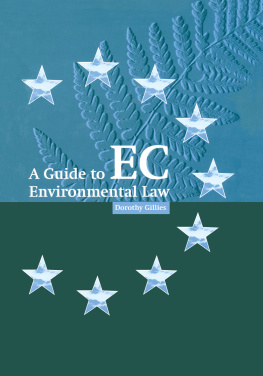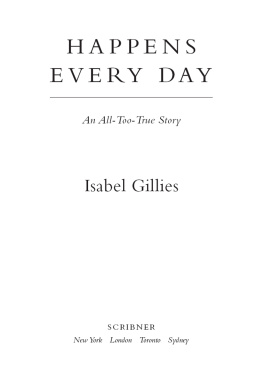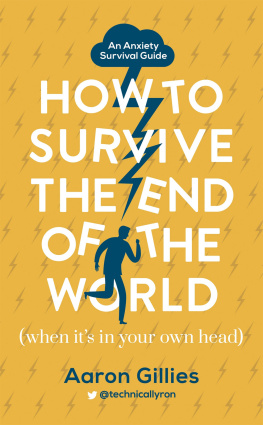Dorothy Gillies - A Guide to EC Environmental Law
Here you can read online Dorothy Gillies - A Guide to EC Environmental Law full text of the book (entire story) in english for free. Download pdf and epub, get meaning, cover and reviews about this ebook. year: 1998, publisher: Routledge, genre: Romance novel. Description of the work, (preface) as well as reviews are available. Best literature library LitArk.com created for fans of good reading and offers a wide selection of genres:
Romance novel
Science fiction
Adventure
Detective
Science
History
Home and family
Prose
Art
Politics
Computer
Non-fiction
Religion
Business
Children
Humor
Choose a favorite category and find really read worthwhile books. Enjoy immersion in the world of imagination, feel the emotions of the characters or learn something new for yourself, make an fascinating discovery.
- Book:A Guide to EC Environmental Law
- Author:
- Publisher:Routledge
- Genre:
- Year:1998
- Rating:4 / 5
- Favourites:Add to favourites
- Your mark:
- 80
- 1
- 2
- 3
- 4
- 5
A Guide to EC Environmental Law: summary, description and annotation
We offer to read an annotation, description, summary or preface (depends on what the author of the book "A Guide to EC Environmental Law" wrote himself). If you haven't found the necessary information about the book — write in the comments, we will try to find it.
A Guide to EC Environmental Law — read online for free the complete book (whole text) full work
Below is the text of the book, divided by pages. System saving the place of the last page read, allows you to conveniently read the book "A Guide to EC Environmental Law" online for free, without having to search again every time where you left off. Put a bookmark, and you can go to the page where you finished reading at any time.
Font size:
Interval:
Bookmark:

1 85383 586 2 hardback
2 Park Square, Milton Park, Abingdon, Oxfordshire OX14 4RN
711 Third Avenue, New York, NY 10017
- BAT best available technique
- CFC chlorofluorocarbon
- CFI Court of First Instance
- CITES Convention on International Trade in Endangered Species of Wild Flora and Fauna
- Commission European Commission
- Community European Community
- COR Committee of the Regions
- COREPER Committee of Permanent Representatives
- Council Council of the European Union
- Dec decision
- DG directorate-general
- DGXI Directorate-General XI (environment, nuclear safety and civil protection)
- Dir directive
- EC European Community
- ECOSOC Economic and Social Committee
- ECR European Court reports
- ECU European currency unit
- EDC European Documentation Centre
- EEC European Economic Community
- EIA environmental impact assessment
- EINECS European Inventory of Existing Commercial Chemical Substances
- EIONET European Environment Information and Observation Network
- EMAS eco-management and audit scheme
- EMEP European Monitoring and Evaluation Programme
- EU European Union
- EURATOM European Atomic Energy Community
- EUR-OP Office for Official Publications of the EC
- European Court European Court of Justice
- GLOBE-EU Global Legislators for a Balanced Environment
- GMO genetically modified microorganism
- HCFC hydrochlorofluorocarbon
- ICE Information Centre for Europe
- IPPC integrated pollution prevention and control
- MEP Member of the European Parliament
- MW megawatt
- OJ Official Journal of the European Communities
- Parliament European Parliament
- PCB polychlorinated biphenyl
- PCP pentachlorophenol
- PCT polychlorinated terphenyl
- pe population equivalent
- PIC prior informed consent
- Reg regulation
- RSPB Royal Society for the Protection of Birds
- SAC Special Area of Conservation
- SCI Site of Community Importance
- SPA Special Protection Area
- UK United Kingdom
- US United States
- VOC volatile organic compound
- WWF Worldwide Fund For Nature
Font size:
Interval:
Bookmark:
Similar books «A Guide to EC Environmental Law»
Look at similar books to A Guide to EC Environmental Law. We have selected literature similar in name and meaning in the hope of providing readers with more options to find new, interesting, not yet read works.
Discussion, reviews of the book A Guide to EC Environmental Law and just readers' own opinions. Leave your comments, write what you think about the work, its meaning or the main characters. Specify what exactly you liked and what you didn't like, and why you think so.









